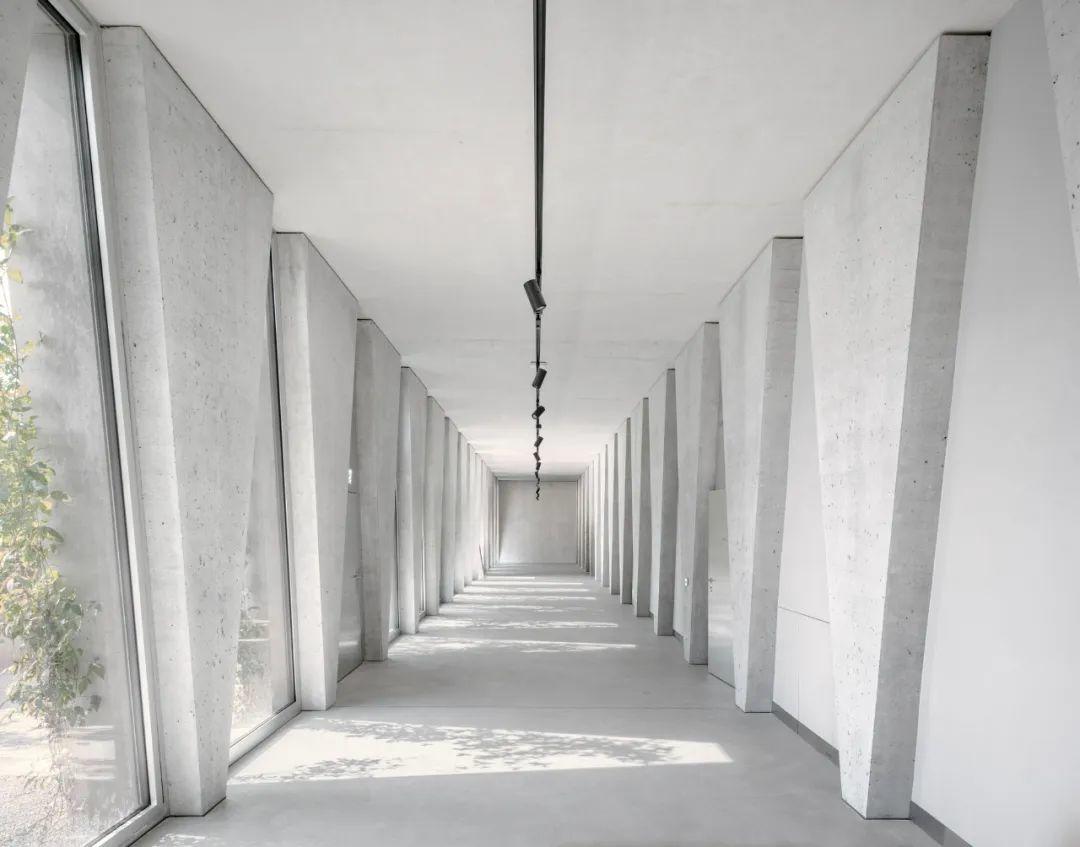
项目地点 瑞士苏黎世
设计单位 BAROZZI VEIGA
建筑面积 1500平方米
建成时间 2019
2012年,位于该项目原址的旧市政大楼被大火烧毁,该大楼曾为Tanzhaus舞蹈中心和瑞士纺织学校使用。2014年,事务所赢得了一国际竞赛,为该地设计一个新的Tanzhaus舞蹈中心,并对利马特河河岸进行改造。
In 2012, the previous-existing municipal building at Wasserwerkstrasse 127a in Zürich- Wipkingen, accommodating the Tanzhaus and the Swiss Textile School, was destroyed by a fire. In 2014 Barozzi Veiga won the international competition carried out by the Amt für Hochbauten Zürich, for the construction of a new Tanzhaus and the transformation of the entire bank of the river Limmat.


设计旨在激活沿河的步行空间,并改善该地区的居住条件。改造巧妙地处理了建筑的形体,很好地将与周围建筑融合。这是苏黎世的一座新文化建筑,它能反映Tanzhaus作为瑞士最重要的当代舞蹈中心之一的重要性。建筑被建在一个斜坡上,以一个简单的、层叠的空间体块呈现,几乎隐匿于环境中。建筑的屋顶上形成了新的公共空间,将原有的沿河道路串联起来。
The project aimed to reactivate the promenade along the river, transforming and redefining the previous residential conditions of the location. The project by Barozzi Veiga consists in a new cultural building for the city of Zürich, which reflects the importance of the Tanzhaus as one of the most significant centres for contemporary dance in Switzerland. The building is defined as a simple and tiered volume of space, integrated into the slope and barely noticeable from the outside. An element that enables a new public space to be generated on its roof and that connects the existing itineraries at different levels that intertwine along its bank.


梯形的立面形式是由传统柱、梁和矩形开口组成的正交结构系统演变而来。这种特殊的形状和隔热混凝土的使用形成了建筑连续的结构立面,同时也形成了建筑的主要特征。统一的立面均匀地向沿河的公共空间开放,将室外空间与室内连接起来,扩展并丰富了该公共空间。梯形的几何形状形成了这种极具渗透性的立面,并能够控制内部自然光的进入。在光照下,立面形式和植被在大厅形成的光影也是其主要特征之一。
The choice of the trapezoidal form is the result of a transformation of the traditional orthogonal system of pillars, beams and rectangular openings. Indeed, the repetition of this particular shape and the use of a performing insulating concrete allowed for a continuous structural façade, which, at the same time, protects and characterizes the building. The uniform façade defines and evenly opens up to the entire public space along the river, connecting the outdoor space to the foyer, extending and enriching the new public space. The geometry of the trapezoidal openings simultaneously allow both for this extremely permeable façade and to control and shape the entry of the natural light inside the building. The resulting shadows given by the facade drawing and the vegetation become one of the main features of the foyer.







建筑分为两层,上层为私用,下层为公用。这种划分允许建筑有不同的入口,可以激活周边路径,并加强与利马特河的联系。下层主门厅贯穿整个横立面,可以从任意入口进入制作室和多功能大厅。这个空间有两层楼高,可以从侧面采光。上层是Tanzhaus办公室和后台空间。
The programme is organized across two levels, separating private uses on the upper level from public uses on the lower one. This division allows for different accesses and activates the circulation around the building, reinforcing its public nature at that level in direct contact with the river Limmat. Here, the main foyer runs over the entire length of the façade and gives access to the production rooms and the main multifunctional hall. This space, which spans two storeys, is provided with daylight on the side. The upper level accommodates the Tanzhaus offices and backstage spaces.



设计通过主立面的塑造解决了建筑与周围环境的关系。建筑的基础结构、连续的立面形式,都是对周围现有元素的一种全新演绎,这些元素包括交错的道路、组装式的桥结构、纵向的码头等。
The building resolves the relationship with its surroundings through the definition of its main elevation. This consists in a sort of infrastructure, a continuous façade that can be read as a reinterpretation of existing surrounding elements, which are evidences of the industrial past of this area (i.e. the overpassing passages, the continuous modular metal structures of the bridge, the baths' longitudinal piers.)







完整项目信息
Full name: TANZHAUS ZÜRICH
Location: Zürich, Switzerland
Client: Eigentümerin Immobilien Stadt Zürich, represented by Stadt Zürich、Amt für Hochbauten
Principal Architects: BAROZZI / VEIGA | Fabrizio Barozzi、Alberto Veiga
Design Team: Katrin Baumgarten, Verena Recla, Patrick Boner, Paola Calcavecchia, Raquel Corney, Marta Grządziel, Adrien Mans, Cristina Porta, Agnieszka Samsel, Ivanna Sanjuan, Malte Sunder-Plassmann, Diletta Trinari, Maria Ubach
Project manager: LeanCONSag | Dominik Schlatter
Structural engineer: Pöyry Schweiz AG
Services engineers: hps energieconsulting AG、Walter Salm, Meier & Partner AG、Gerber + Partner Haustechnik AG
Façade consultant: GKP Fassadenplanung AG
Building physics and Minergie consultant: Energiekonzepte AG
Stage Design: Tokyoblue GmbH
Acoustic consultant: Rocket Science GmbH
Landscape Architects: Müller Illien Landschaftsarchitekten GmbH
Signage: WBG AG | Weiersmüller Bosshard Grüninger
Usable floor area: 1500m²
Competition: 2014
Project: 2015-2018
Construction: 2016-2019
Budget: 14,398,000 CHF (aprox. 12,960,000 €)
本文由BAROZZI VEIGA授权有方发布,欢迎转发,禁止以有方编辑版本转载。
上一篇:黄文菁:做自己该做的事 | 建筑师在做什么145
下一篇:曲面屋顶下的开放空间:山王办公室 / Studio Velocity